|
|
|
2004 Worldwide Survey Results |
| You
will find below the analysis of the answers to the following
questions: |
|
 1 . How long will PowerBuilder be used in your
company ?
1 . How long will PowerBuilder be used in your
company ?
 2 . In 2004, will PowerBuilder be
used to develop or maintain applications?
2 . In 2004, will PowerBuilder be
used to develop or maintain applications?
 3 . How many developers will use
PB in your company in 2004 ? (approximately)
3 . How many developers will use
PB in your company in 2004 ? (approximately)
 4 . Which PB version do you currently
use?
4 . Which PB version do you currently
use?
 5 . In 2004, do you plan to migrate
toward a more recent PB version?
5 . In 2004, do you plan to migrate
toward a more recent PB version?
 6 . Do you use PB to develop your
Web Applications?
6 . Do you use PB to develop your
Web Applications?
 7 . Which other technologies is
(or will be) used in your company?
7 . Which other technologies is
(or will be) used in your company?
 8. If you use a framework, what
type do you use?
8. If you use a framework, what
type do you use?
 9 . As a developer, what is your
opinion about PowerBuilder?
9 . As a developer, what is your
opinion about PowerBuilder?
 10 . Countries
10 . Countries |
| 1) How long will
PowerBuilder be used in your company ? |
|
|
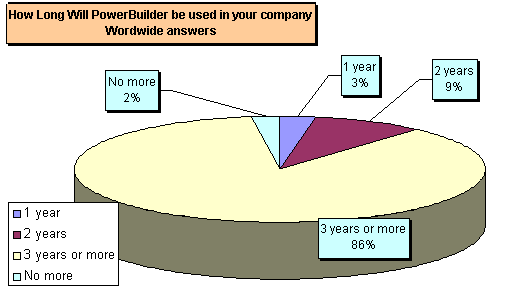
|
|
|
|
| 1-
Few users declare not to use PowerBuilder anymore: the developers
who answered this survey are those who go on using PowerBuilder...
2- Most of the people who answered plan on using PowerBuilder
: 86% assess to use it for more than 3 years! This statistic
has increased by 4 points from last year's survey (86% in
2004 vs 82% in 2003).
3- The USA often have the lead concerning technical choices.
In this precise case, the forecasts on the of use of PowerBuilder
are almost the same in the USA as in the other countries. |
|
|
|
|
Top |
| 2)
In 2004, will PowerBuilder be used to develop or maintain applications? |
|
|
|
see
2003 results |
| In
2002, developers all mentioned they were working on existing
applications.
In 2003, the results were very different : 6% of the users
work on new applications.
In 2004, this trend strengthens. Indeed, we register an increase
of 5 points on the number of new projects.
It is important to notice that 56% of the respondants use
PB for both existing and new applications, which means they
will continue to rely on PowerBuilder.
|
|
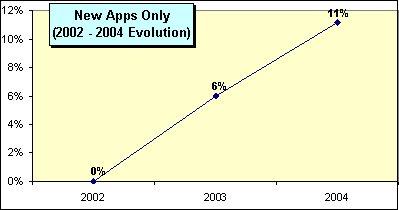 |
|
|
| 3)
How many developers will use PB in your company in 2004 ? (approximately) |
|
|
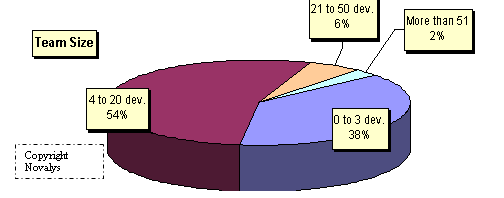
|
see
2003 results |
| As
before, PowerBuilder is still being employed for "large"
projects; department projects or company projects.
The average PB project has increased by 9%: over 50% of the
teams contain an average of 9 developers in 2004 vs 8,3 in
2003.
|
|
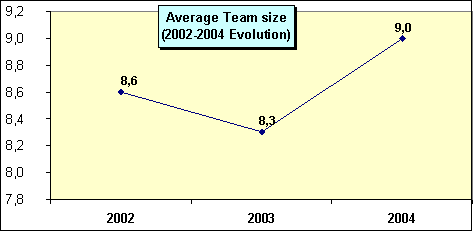 |
|
|
| 4)
Which PB version do you currently use? |
|
|
| In
2003, the PB9 version was quoted by 8% of the users. It was
the most frequently used version.
In 2004, this version is used by 1/3 of the participants,
another 1/3 are still working with PB8 (35%).
Nevertheless, 31% of the polled assess they are working with
an older version than PB7, which isn't supported by Sybase
anymore.
|
|
|
| 5)
In 2004, do you plan to migrate toward a more recent PB version? |
| |
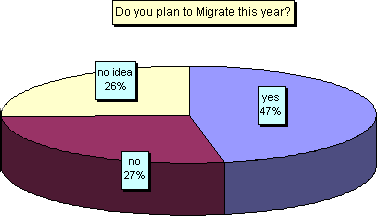
|
|
Half
of the teams (47%) plan to migrate to a more recent version
of PowerBuilder in 2004, which confirms their investment in
Sybase's developmetn tool.
|
|
| |
| 6)
Do you use PB to develop your Web Applications? |
|
|
|
|
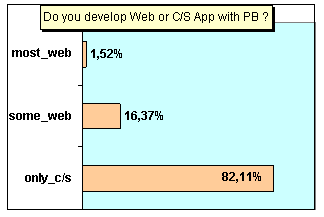
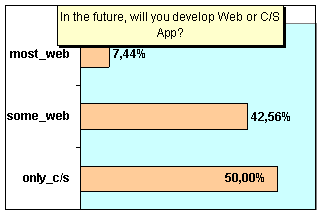
|
see
2003 results |
| The
use of PowerBuider so as to develop Web applications seems to
be very stable :
1/5 of the users work in PB to develop their Web applications
(same as in 2004 and in 2003).
Half of the users plan to develop some of their web applications,
if not all of them, with PowerBuilder! |
|
| Top
|
| 7)
Which other technologies is (or will be) used in your company? |
|
|
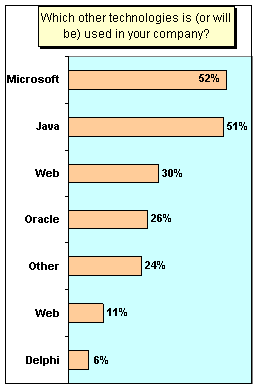
|
see
2003 results |
| Microsoft
and Java are the most frequently used by the participants.
Microsoft made a significant advance in this ranking this
year : its technologies represent now more than half of the
responses (52%) against 1/3 in 2002 (30%) and hardly an half
in 2003 (47%).
These results clearly illustrate Microsoft's investment in
the .NET technology.
Java is still very often used with 51% of the participants
this year.
It is important to notice that there are many more answers
to this question this year; companies have a better assessment
of their technical tendencies. They plan to use several tools
simultaneously.
|
|
|
|
| Top |
| 8)
If you use a framework, what type do you use? |
|
|
|
|
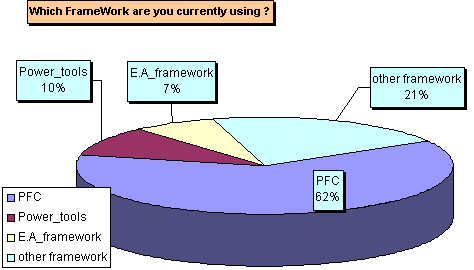
|
|
| Sybase
is still the framework most quoted by the users: more than 2/3
of the participants use it!
Powertools is still used by 1/10 of the polled although the
diffusion of this tool has been interrupted since 1997.
EAF (Entreprise Application Framework) is for the first time
mentioned in this ranking. We can probably explain its success
by its technical positioning (Applications n-tiers) and its
price positioning (Open source by Cynergy System). |
|
| Top
|
| 9)
What is your opinion about PowerBuilder? |
|
see
2003 results |
| Generally
speaking, the satisfaction rate of the developers has increased
drastically:
- 39% gave PowerBuilder the highest mark (between 9/10 and
10/10) vs 23% in 2003 and 18% in 2002.
- only 13% marked the product under 6/10 (18% in 2003 and
17% in 2002).
|
|
|
|
|
| 10)
Countries |
|
|
| Top |